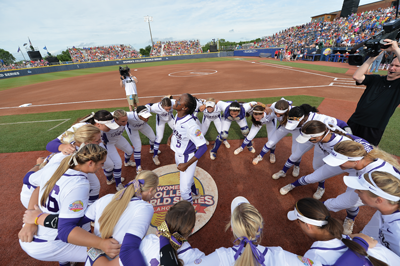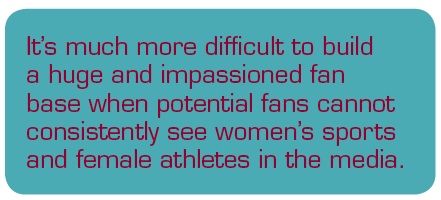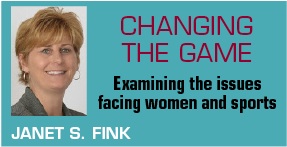Girls and women are participating in sports in record numbers in the United States and delivering incredible performances. From the U.S. team’s victory in the 2015 Women’s World Cup, to Serena Williams’ amazing 33 Grand Slam match winning streak, to Ronda Rousey’s domination in the UFC, female athletes are captivating fans with their athleticism in spite of some significant hurdles.
Women’s sports and female athletes still receive far less corporate sponsorship and fewer advertising dollars than their male counterparts. WNBA star Maya Moore discussed the lack of attention surrounding the WNBA in a piece in The Players’ Tribune and noted, “Somewhere up the chain of command — in companies that, in many ways, dictate what is ‘cool’ — people are making choices not to celebrate the WNBA and its players. … Engaged and invested cultural influencers and partners in corporate America are crucial in elevating the profile of the WNBA.”
 |
The NCAA Women’s College World Series outdrew its male counterpart by 31 percent.
Photo by: GETTY IMAGES
|
But the WNBA is not the only women’s league that suffers from a lack of corporate sponsorship. Not by a long shot. Tom Kingsley, director of sport and sponsorship at Ernst & Young, recently noted to The [London] Independent that “less than half of 1 percent of sport sponsorship is invested in women’s sport.” Less than half of 1 percent! Corporate executives may argue that such decisions are entirely market-driven. That is, they make decisions about sponsorship by determining which sports leagues, teams and athletes will provide the greatest ROI. But if that is true, consider that women’s sports participation is at an all-time high:
■ More than 3.3 million girls participate in high school sports in America.
■n 42 percent of intercollegiate athletes are women.
■ Women make up 58 percent of participants at running events.
■ Women control 70 to 80 percent of consumer purchases.
■ Women purchase more than 50 percent of traditionally male products, 68 percent of automobiles, and control more than 60 percent of all personal wealth in the United States.
How is it logical that less than half of 1 percent is invested in women’s sports?
Considering these facts, the sponsorship of women’s leagues and female athletes is an incredible bargain and opportunity. Corporations can create partnerships with far less investment than in men’s sports and yet appeal to the female (and male) consumer segment in different ways.
“Sponsoring women’s sport is a tangible way for businesses to demonstrate that they care about the girls and women in their workforce,” Sally Horrox, founder of Y Sport, told The Independent. “In a cynical world, it’s about actions speaking louder than words.”
In fact, across the globe, corporate executives have begun to realize the rich opportunity in sponsoring women’s sports. Recently, energy firm SSE became a sponsor of the Women’s FA Cup, Kia became the official partner of England Women’s Cricket, and Investec became the official sponsor of the Women’s Hockey League in England — to name just a few of the new major partnerships. As Kingsley noted, “In business terms, women’s sport is an emerging market and offers great potential.”
 |
Sponsorship decisions are, in part, determined by media audiences, and the two are interrelated. Audiences grow with media hype, making sponsorship more appealing, while sponsorship support (and activation) increases consumer awareness and, subsequently, media attention. England and Wales Cricket Board Chief Executive David Collier appears to recognize this as he talked about the new partnership with Kia: “It also illustrates how important media exposure is for the promotion of women’s cricket and we are indebted to our principal live broadcast partners, Sky Sports and BBC Radio, whose excellent coverage plays such a vital role in making the sport attractive to potential business partners.”
Unfortunately, the media coverage of women’s sports in the United States remains incredibly low. In the latest version of a 25-year longitudinal study of gender in sports highlights and news shows conducted by researchers at Purdue University and the University of Southern California, ESPN’s “SportsCenter” devoted just 2 percent of all airtime to women’s sports in 2014, a figure that has remained relatively steady since 1999. An analysis of the sports news via three Los Angeles network affiliates produced similar results: Only 3.2 percent of airtime went to women’s sports in 2014, and again, this figure has remained relatively stable for the past 25 years. This lack of media coverage is problematic because it’s much more difficult to build a huge and impassioned fan base when potential fans cannot consistently see women’s sports and female athletes in the media.
And yet, in spite of this negligible media coverage, people (both men and women) are interested in women’s sports. The final of the Women’s World Cup garnered 25.4 million viewers, rendering it the most watched soccer match in U.S. history, men’s or women’s. A survey conducted before the World Cup games began showed that 63 percent of American women planned to watch, and 52 percent of those said they would watch because they want to support female athletes. The 2015 NCAA women’s basketball championship drew 3.1 million viewers, and the Women’s College World Series viewership outdrew the Men’s College World Series by 31 percent.
There is a market for women’s sports. Imagine how much larger it would be with increased media coverage.
Consider this: There were many skeptics when Fox declared it would devote 200 hours to the Women’s World Cup. Those skeptics doubted there would be enough audience demand to warrant the costs. Fox’s decision was vindicated as it shattered viewership records and netted 400 percent more advertising revenue than the 2011 Women’s World Cup and delivered a great platform for participating sponsors.
Savvy executives need to realize the significant, untapped opportunity to connect with important consumer groups through women’s sports and female athletes. They offer tremendous value for the investment. The time is right to get in the women’s game.
Janet S. Fink (jsfink@isenberg.umass.edu) is professor and department chair of the Mark H. McCormack Department of Sport Management in the Isenberg School of Management at the University of Massachusetts Amherst.






